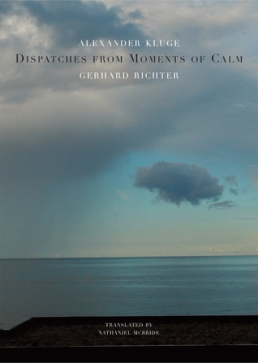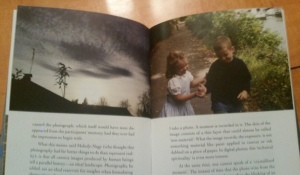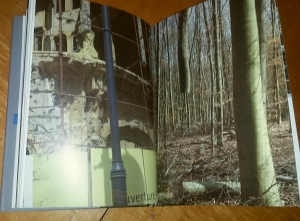As we witness an unprecedented assault on the integrity and role of journalists and the news media, fueled by recent events in the US—and, let’s be fair, in many other nations in our current climate of political unease—this collaborative effort to re-imagine an alternative approach to capturing reality is ever more timely and precious. The genesis of Dispatches from Moments of Calm (Seagull Books, 2016) lies in an unusual experiment. For one day, October 5, 2012, all of the noisy and distressing political reportage evaporated from the pages of the German national newspaper, Die Welt. In its place? Thirty pages of photographs capturing the simplicity of the everyday—a quiet interlude in restless times, created and directed by renowned artist Gerhard Richter.
 Inspired by this singular attempt to create a “moment of calm,” writer and film maker, Alexander Kluge, started to work on a collection of small stories to accompany the images. Richter responded in turn with the proposal of a collaboration. He added more photos; Kluge wrote more stories. The resulting book—a continuation of their first successful joint publication, December (2010/2012)—is an important, and given the mood of the current times and the circumstances of the project’s origin, a more meditative and philosophical work.
Inspired by this singular attempt to create a “moment of calm,” writer and film maker, Alexander Kluge, started to work on a collection of small stories to accompany the images. Richter responded in turn with the proposal of a collaboration. He added more photos; Kluge wrote more stories. The resulting book—a continuation of their first successful joint publication, December (2010/2012)—is an important, and given the mood of the current times and the circumstances of the project’s origin, a more meditative and philosophical work.
The photographs scattered throughout the text isolate the ordinary instant. The atmosphere is placid, low-key. We see a dog sleeping in the sun, the blurred image of a family at a meal, a deserted downtown street, images of nature, children at play, a moody seascape, and more. But each image exists in a space apart from time and the world. And Kluge’s fictions, taking off as they so frequently do, from real life people, events, and ideas, offer the ideal counterpoint. Many of the stories explicitly explore the intersection between art, music and reality:
László Moholy-Nagy was asked whether a photograph reproduces a piece of reality. He denied the claim. He replied that a photograph is constituted by the fact that it concentrates on an actual moment and records it, becoming a textual addition existing outside the world. He knew, the Bauhaus man continued, series and networks of such photographs, which relate to reality or current events like a mirror (including the gaps in that reality, to a silence or to a nothingness), but which, when cut off from the rapidly receding stratification of time, would form themselves into their own republic, one that would superimpose itself (like an El Niño mudslide) onto the original impression that caused the photograph, which itself would have disappeared from the participants’ memory, had they never had the impression to begin with.
Dispatches comprises 89 stories and 64 pictures. Some of the stories—which range from a paragraph or two to a couple of pages—were composed to accompany, after the fact, specific images from the original Die Welt project. Both Kluge and Richter added more contributions on their own. In the resulting book, the confluence between images seems to be accidental, rather than exacting. Where a connection exists, the image is unlikely to occur near the corresponding story. This arrangement adds to the incidental flow of the work. There is, however a thematic structuring at play.
 The book is divided into five parts. The stories in first section turn on the element of chance. With narratives featuring real figures from science, music, and history, alongside parables drawn from nature and from everyday life, Kluge explores the vagaries of fate and circumstance. The consequences, happy or unhappy, have the effect of promoting a sense of disequilibrium—an awareness of the fleeting quality of those moments of calm that we experience.
The book is divided into five parts. The stories in first section turn on the element of chance. With narratives featuring real figures from science, music, and history, alongside parables drawn from nature and from everyday life, Kluge explores the vagaries of fate and circumstance. The consequences, happy or unhappy, have the effect of promoting a sense of disequilibrium—an awareness of the fleeting quality of those moments of calm that we experience.
The second part takes us into the city starting with stories set in modern urban spaces, moving back in time to vignettes that speculate on the Mesopotamian origins of the city-state and ruminations on the nature of the concept “city.” This section closes with a story featuring sociologist Richard Sennett:
The city that we carry around inside ourselves, he said, is visible. But when you see a city destroyed by bombs, one which you do not know and means nothing to you, and you nevertheless feel sad, then you can see from this reaction that we carry around inside ourselves just such an invisible city. You see the city only when it has been lost.
These words seamlessly lead into a collection of stories set in the Middle East—Beirut, Lebanon, Syria, Israel—engaging current events, history and even opera to reflect, in words, the very instants Moholy-Nagy imagined captured in the mirror of a photograph.
 The final two sections sharpen the focus on questions of reality—how we report it, record it, place ourselves in relation to it. The philosophical musings Kluge entertains in these brief stories offer so much to contemplate. His ability to exploit the fluid intersection between what we, especially in English language literature, want to divide into fact and fiction, lends his stories the sense that these should be considered fragmentary pieces of nonfiction. The influence that his work had on W. G. Sebald is evidenced in this regard. These stories, parables, and reflections are, in themselves, narrative truths—regardless of whether they describe events as they really occurred, or if they even occurred at all. Kluge wants to make you stop, in the moment, and think. Here, as an illustration, is one of my favourite stories, in its entirety to provide a taste of Kluge at work:
The final two sections sharpen the focus on questions of reality—how we report it, record it, place ourselves in relation to it. The philosophical musings Kluge entertains in these brief stories offer so much to contemplate. His ability to exploit the fluid intersection between what we, especially in English language literature, want to divide into fact and fiction, lends his stories the sense that these should be considered fragmentary pieces of nonfiction. The influence that his work had on W. G. Sebald is evidenced in this regard. These stories, parables, and reflections are, in themselves, narrative truths—regardless of whether they describe events as they really occurred, or if they even occurred at all. Kluge wants to make you stop, in the moment, and think. Here, as an illustration, is one of my favourite stories, in its entirety to provide a taste of Kluge at work:
For many centuries, thousands of monks in monasteries between Ireland and Byzantium, dotted like islands across the barbaric land, were writing out the holy texts. Their zeal and their great efforts produced mistakes. The result was that the texts imperceptibly expanded. One learned monk in Samanca was delighted to find a text by Ovid on the back of a copy of the apocryphal LOGION OF ST JOHN. The copyist on the island of Reichenau could not resist including this interpolation. In this way, a text was expanded in a distinctly “unholy” manner.
A transcription of texts (just as if evolution had been tinkering with their DNA texts) doesn’t only create lines to new future texts. It can also be reconstructed in the direction of paradise. The way there leads through indeterminacies. ‘Nearer, my God to Thee’ was the music played by the orchestra on board the Titanic as the ship went down. But it is also the working instructions to copyists of all countries, who are driven from the omphalos of experience into the parallel world (heterotopia), the pre-world history and the future world (the world of our children, who are so attached to life). For copyists, all images are NOW-TIME.
I don’t know if it is the nature of the project from which this collaboration arose, that is, as an attempt to visually introduce an element of calm to the daily news cycle, that gives this book its impact, but in contrast to December, which I read at the end of last year (my review is here), Dispatches from Moments of Calm is a more powerful, comprehensive work. But then it may be a question of timing. Originally published in German in 2013, the driving forces against which Richter’s photographic interlude at Die Welt was superimposed, have not slowed. Uncertainty has increased and continues to grow. But as Kluge and Richter, two of the most influential and respected artists of their generation stand to remind us, art is more critical than ever at times like the one we find ourselves in at the end of 2016.
Like the dome of lights over a great city, the STATE OF THE NEWS forms an aura in which a general notion of what matters in the world coalesces.
It is out of such NEWS VALUES and not out of the facts themselves that the daily image of the reality of our world is put together. The products of poetry form an antithesis to this daily fluctuation. In painted images, and in the narratives of short stories and novels, time outside stands still.
Dispatches from Moments of Calm by Alexander Kluge and Gerhard Richter is translated by Nathaniel McBride and published by Seagull Books. A second edition of their earlier collaboration, December (translated by Martin Chalmers) will be published, also by Seagull, in paperback, in Spring 2017.

I saw an exhibition of Richter’s work at the Tate Modern 4 or 5 years ago, a major retrospective including pieces from various points in his career. I can still recall the effect these works had on me, especially some of the paintings of his family. This book sounds equally powerful.
LikeLiked by 2 people
Richter and Kluge are an interesting team. In the back of the book they are listed with their baby pictures and birthdates—they are only a handful of days apart in age, both now in their mid-80s.
LikeLike
I read a review of this recently, & your post adds to my sense that this is worth seeking out – thanks
LikeLiked by 2 people
I’ve had it since just after it came out but my reading has been slowed by life events and losses this year. Reading it in the post-truth, post-Brexit/Trump state of unreality lends an extra element to the meditations (and need for moments of calm too).
LikeLiked by 1 person
It’s so funny that you just posted this because I am currently reading December. It is quite a book and I think I will like this one even more. Great review, Joe!
LikeLiked by 2 people
I read December last December and I liked it and was intrigued by the flat, serious tone to Kluge’s stories that seem like nonfiction. (Having read more Sebald as well as Sarotar’s Panorama I am more intrigued by this quality.) The themes and images in this book are more varied and Kluge’s philosophical and film director sides come through more. There is a lot to think about here.
LikeLiked by 1 person
Good post! I thought of William Carlos Williams, “Asphodel, that greeny flower”, though I can’t replicate his line endings here for some reason…
“Look at what passes for the new.
You will not find it there but in despised poems.
It is difficult to get the news from poems
yet men die miserably every day for lack of what is found there.
Hear me out for I too am concerned and every man who wants to die at peace in his bed besides.”
LikeLiked by 2 people
Thanks for the poem Theresa. It is very timely and appropriate.
LikeLike
What a lovely sounding book. I think we need more calming influences in our daily lives, definitely…
LikeLiked by 2 people
Interestingly the “calm” in the stories is sometimes sad or unhappy. But the book offers much food for thought.
LikeLiked by 1 person
A beautiful, thoughtful review of a book which sounds equally beautiful and thoughtful. It’s a lovely idea to refocus on the simple joys of daily life, that sliver of sunlight slipping through the clouds. Gorgeous pictures, and the stories sound both intelligent and intriguing.
LikeLiked by 2 people
Thank you. As I indicated to Karen above, some stories are sad or deal with difficult themes, but they don’t evoke the horror most of us feel just looking at the way the world seems to be spiraling of late.
LikeLiked by 1 person
How wonderful and beautiful and so, so necessary!
LikeLiked by 1 person
True, so true.
LikeLiked by 1 person
This review was heart-expanding and hopeful. The project certainly sounds like one for our times and I shall be seeking out this book. Thanks for drawing my attention to it.
LikeLiked by 2 people
I hope you like it. It is hard to capture the feel of the work. Heart-expanding is a good expression.
LikeLiked by 1 person
I bought the book and am reading it slowly, looking at it carefully, savoring it. thanks!
LikeLiked by 2 people
I’m glad you’re enjoying it. This is definitely a book that invited you to take your time. Best wishes for the holiday season.
LikeLike
Thanks for this review, I’ll order the book now. I’m on way to Cologne to see Richter in Museum Ludwig later this week. What a great artist!
LikeLiked by 1 person